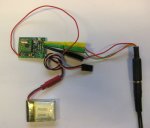Hi guys,
Currently there is no pre-made board I'm aware of anyway that does just this. I know there are Proto boards but I want something I can, once built just put in a box without making another up on stripboard which often ends poorly.
The idea is to have one multi purpose board based around an 08m2 for my different projects rather than using stripboard etc. I know I cannot program the chip on this board, this is ok as I purchased a cheap ZIF socket which I use then port on to my strip boards. I like things small so the download socket/molex takes valuable real estate in my opinion.
Now before I get 50 or so of these board made up would you guys give me your opinions on whether this will work or not, all comments good or bad very gratefully received.
Now bear in mind this is a multi purpose board so not all components will be used on all projects.
For instance if we are using all the pins as outputs the transistors, R8 10k SIL and the R3,5,6,7 1k's will be fitted however if we are using the pin as an input the transistor and associated resistor will be linked across and not installed (obviously).
The R8 10k SIL will always be installed, as whether IN/OUT will always need to be pulled down.
VR1/2, 2 different voltage regulators could be fitted, one giving 100/150ma or 7805 1A.
J1, jumper, will have the program test for input to change the way it runs. Is the 10k Sil pulling this down to ground ok?
DCC - Standard 104 decoupling cap
T2 and T3, T2 Serial IN, used for connecting 2 of these boards together, T3 can be used as either the output data to work long side T3 or used as a single wire data IN/OUT as discussed here
C1 as this is on the Input side this will be a 25v 100nf, while C2 being the output side will be a 10v 100nf.
Vout+ is a 5v+ for use as the reference to the inputs (when OP3, 5,6 or 7 are used an input). Am I correct in thinking that resistors R3,5,6,7 won't need to be used when used as inputs as the 10k SIL will pull to ground.
D1 Standard polarity diode. D2 Power on LED.
Transistors used are:
http://www.rapidonline.com/Electronic-Components/Bc639-Tran-Npn-80v-1a-To92-81-0080
Cap's used are:
http://www.rapidonline.com/Electronic-Components/100uf-25v-105deg-Nrsz-Electro-Capacitor-11-1545
Thanks in advance for your time reading this thread.
Currently there is no pre-made board I'm aware of anyway that does just this. I know there are Proto boards but I want something I can, once built just put in a box without making another up on stripboard which often ends poorly.
The idea is to have one multi purpose board based around an 08m2 for my different projects rather than using stripboard etc. I know I cannot program the chip on this board, this is ok as I purchased a cheap ZIF socket which I use then port on to my strip boards. I like things small so the download socket/molex takes valuable real estate in my opinion.
Now before I get 50 or so of these board made up would you guys give me your opinions on whether this will work or not, all comments good or bad very gratefully received.
Now bear in mind this is a multi purpose board so not all components will be used on all projects.
For instance if we are using all the pins as outputs the transistors, R8 10k SIL and the R3,5,6,7 1k's will be fitted however if we are using the pin as an input the transistor and associated resistor will be linked across and not installed (obviously).
The R8 10k SIL will always be installed, as whether IN/OUT will always need to be pulled down.
VR1/2, 2 different voltage regulators could be fitted, one giving 100/150ma or 7805 1A.
J1, jumper, will have the program test for input to change the way it runs. Is the 10k Sil pulling this down to ground ok?
DCC - Standard 104 decoupling cap
T2 and T3, T2 Serial IN, used for connecting 2 of these boards together, T3 can be used as either the output data to work long side T3 or used as a single wire data IN/OUT as discussed here
C1 as this is on the Input side this will be a 25v 100nf, while C2 being the output side will be a 10v 100nf.
Vout+ is a 5v+ for use as the reference to the inputs (when OP3, 5,6 or 7 are used an input). Am I correct in thinking that resistors R3,5,6,7 won't need to be used when used as inputs as the 10k SIL will pull to ground.
D1 Standard polarity diode. D2 Power on LED.
Transistors used are:
http://www.rapidonline.com/Electronic-Components/Bc639-Tran-Npn-80v-1a-To92-81-0080
Cap's used are:
http://www.rapidonline.com/Electronic-Components/100uf-25v-105deg-Nrsz-Electro-Capacitor-11-1545
Thanks in advance for your time reading this thread.
Last edited:


.jpg)